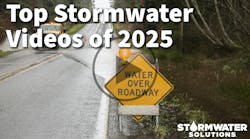About the author: Vaikko Allen is region regulatory director for Contech Engineered Solutions. Allen can be reached at [email protected].
Trash is ubiquitous in the urban environment, with impacts that are as persistent as the materials themselves. When transported through storm water systems into receiving waters, trash can smother benthic habitats and limit the growth of aquatic vegetation. When it accumulates on shorelines or is snared by vegetation, it is an aesthetic nuisance. When it is mistaken for food and ingested by wildlife, trash can lead to sickness or starvation and open pathways for bioaccumulation in predatory species.
This is not a small problem. In 2014 it was estimated that there were 5.25 trillion pieces of trash weighing 268,940 tons floating in the world’s oceans, significantly outweighing the total plankton biomass in many areas. Thankfully, among storm water-borne pollutants, trash is relatively easy to observe and capture. It also is relatively easy to rally the general public around the need to control it.
Fifteen years ago, Los Angeles turned its attention to storm water-borne trash, primarily to improve the quality of its world-class beaches, and adopted the first of 15 trash total maximum daily loads (TMDLs). This effort generally has been regarded as a success, with a near 100% reduction of trash discharged via storm water compared to baseline loads, as reported by permittees. These trash TMDLs established a numeric goal of zero trash in receiving waters, recognizing that receiving waters have no assimilative capacity for trash. By this logic, any water body with any amount of trash in it is impaired.
Recognizing the administrative infeasibility of developing and enforcing TMDLs for all receiving waters, the California State Water Resources Control Board instead passed trash control amendments to the water quality control plans that drive NPDES permit requirements. These amendments became effective in December 2015 and require permittees across the state to reduce trash discharged from priority land uses by 100% within 15 years. This is an ambitious yet achievable goal with an estimated additional incremental cost somewhere between $1 billion and $3 billion.
Throughout the trash TMDL and trash amendment process, transferrable lessons have been learned. Crucially, trash has been defined as improperly discarded materials larger than 5 mm in diameter, and a BMP-based compliance pathway has been established, relying on certified “full-capture systems” that trap all trash transported in the one-year, one-hour design storm. Quantification of the effectiveness of institutional controls like product bans, street sweeping, and public education also is underway, and monitoring and compliance reporting strategies have been developed.
These pioneering efforts are not perfect, but should be celebrated. Given the ubiquity and persistence of trash, especially plastics, virtually every water body that receives runoff from urban areas is impaired and would benefit from adopting a similar program. Any structural or institutional trash control strategies that result will visibly improve the quality of the environment and are a good first step toward controlling other impactful, harder-to-remove pollutants like nutrients, sediment, heavy metals and bacteria. The foundational work has been done in California, a state set to transition from exporting waterborne trash to exporting waterborne trash control programs.
Download: Here


